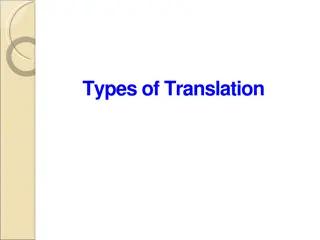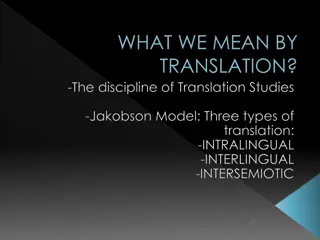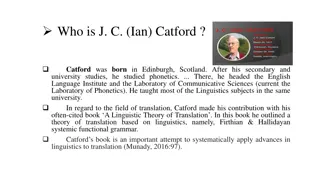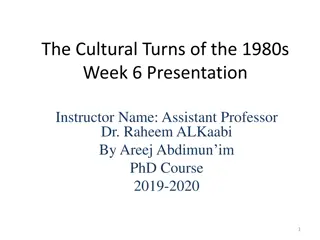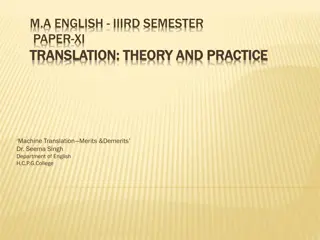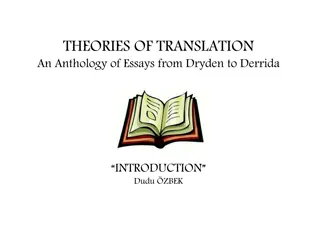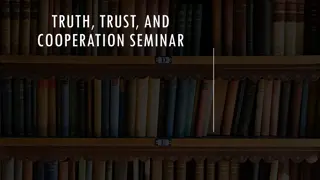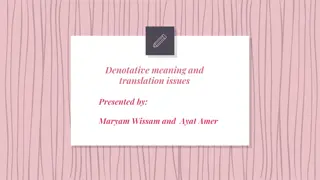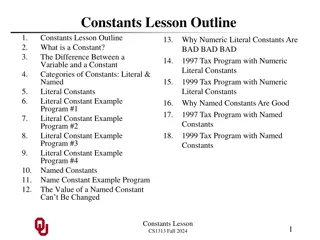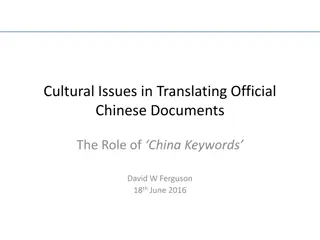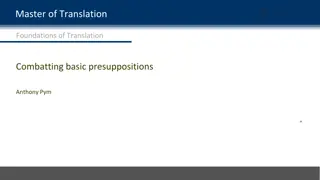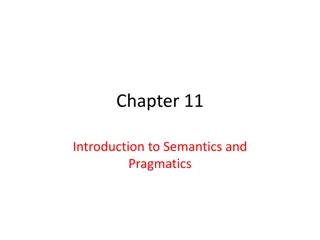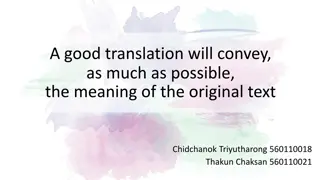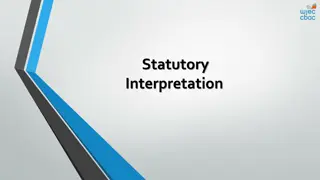Evolution of Translation Theory: From Literal to Sense-for-Sense
Western translation theory up to the 20th century revolved around the debate of literal, free, and faithful translation. This discussion traces back to Cicero and St. Jerome and has influenced translation practices for centuries. While some advocated for word-for-word translations, others, like St. Jerome, emphasized sense-for-sense rendition to convey the essence of the original text effectively. This shift from literal to sense-for-sense translation marked a significant evolution in translation theory.
Download Presentation

Please find below an Image/Link to download the presentation.
The content on the website is provided AS IS for your information and personal use only. It may not be sold, licensed, or shared on other websites without obtaining consent from the author. Download presentation by click this link. If you encounter any issues during the download, it is possible that the publisher has removed the file from their server.
E N D
Presentation Transcript
Up until the second half of the twentieth century, western translation theory seemed locked in what George Steiner (1998: 319) calls a sterile debate over the triad of literal , free and faithful translation. The distinction between word-for-word (i.e. literal ) and sense-for-sense (i.e. free ) translation goes back to Cicero (first century BCE) and St Jerome (late fourth century CE) and forms the basis of key writings on translation in centuries nearer to our own.
And I did not translate them as an interpreter, but as an orator, keeping the same ideas and forms, or as one might say, the figures of thought, but in language which conforms to our usage. And in so doing, I did not hold it necessary to render word for word, but I preserved the general style and force of the language.
The interpreter of the first line is the literal ( word-for-word ) translator, while the orator tried to produce a speech that moved the listeners. In Roman times, word-for-word translation was exactly what it said: the replacement of each individual word of the ST (invariably Greek) with its closest grammatical equivalent in Latin.
In a short but famous passage from his Ars Poetica (20 BCE?),2 underlines the goal of producing an aesthetically pleasing an creative text in the TL, had great influence on the succeeding centuries. St Jerome, the most famous of all translators, cites the authority of Cicero s approach to justify his own Latin revision and translation of the Christian Bible.
Now I not only admit but freely announce that in translating from the Greek except of course in the case of the Holy Scripture, where even the syntax contains a mystery I render not word-for-word, but sense-for-sense. (St Jerome 395 CE/1997: 25) St Jerome bound up with the translation of the Bible and other religious and philosophical texts. Although some scholars (e.g. Lambert 1991: 7) argue that these terms have been misinterpreted, Jerome s statement is now usually taken to refer to what came to be known as literal (word-for-word) and free (sense-for-sense) translation. Jerome rejected the word-for-word approach because, by following so closely the form of the ST, it produced an absurd translation, cloaking the sense of the original. The sense-for- sense approach, on the other hand, allowed the sense or content of the ST to be translated. In these poles can be seen the origin of both the literal vs. free and form vs. content debate that has continued until modern times.
Any translation diverging from the accepted interpretation was likely to be deemed heretical and to be censured or banned. An even worse fate lay in store for some of the translators. The most famous examples are those of the English theologian-translator William Tyndale and the French humanist Etienne Dolet, both burnt at the stake. Tyndale, a formidable linguist who was said to have mastered ten languages, including Hebrew, and whose extraordinary English Bible was later used as the basis for the King James Version, was abducted, tried for heresy and executed in the Netherlands in 1536 (Bobrick 2003, Chapter 2). Dolet was condemned by the theological faculty of Sorbonne in 1546, apparently for adding, in his translation of one of Plato s dialogues, the phrase rien du tout ( nothing at all ) in a passage about what existed after death. The addition led to the charge of blasphemy, the assertion being that Dolet did not believe in immortality. For such a translation error he was executed.
But advances in the study and knowledge of the Biblical languages and typified by Erasmus s edition of the Greek New Testament in 1516 and the general climate of the Reformation and spurred by the new technology of the printing press, led to a revolution in Bible translation practice which dominated sixteenth- century book production in Europe (Bobrick 2003: 81). Non-literal or non-accepted translation came to be seen and used as a weapon against the Church. The most notable example is Martin Luther s crucially influential translation into East Central German of the New Testament(1522) and later the Old Testament (1534). classical scholarship,
-While Luthers treatment of the free and literal debate does not show any real advance on what St Jerome had written 1,100 years before, his infusion of the Bible with the language of ordinary people and his consideration of translation in terms focusing on the TL and the TT reader were crucial.
Luther had been heavily criticized by the Church for the addition of the word allein ( alone/ only ), because there was no equivalent Latin word (e.g. sola) in the ST. The charge was that the German implies that the individual s belief is sufficient for a good life, making the work of the law (i.e. religious law) redundant. Luther counters by saying that he was translatinginto pure, clear German , where allein would be used for emphasis.
Typical of this is his famous quote extolling the language of the people: You must ask the mother at home, the children in the street, the ordinary man in the market and look at their mouths, how they speak, and translate that way; then they ll understand and see that you re speaking to them in German.
England of the seventeenth century with Denham, Cowley and Dryden marked an important step forward in translation theory with deliberate, reasoned statements, unmistakable in their purpose and meaning . At that time, translation into English was almost exclusively confined to verse renderings of Greek and Latin classics.
His approach is also to counter the inevitable loss of beauty in translation by using our wit or invention to create new beauty. In doing this, Cowley admits he has taken, left out and added what I please to the Odes (Amos, p. 150). Cowley even proposes the term imitation for this very free method of translating. The idea was not, as in the Roman period, that such a free method would enable the translator to surpass the original; rather that this was the method that permitted the spirit of the ST to be best reproduced.
In the preface to his translation of Ovids Epistles in 1680, Dryden (1680/1992: 17) reduces all translation to three categories: (1) metaphrase : word by word and line by line translation, which corresponds to literal translation; (2) paraphrase : translation with latitude, where the author is kept in view by the translator, so as never to be lost, but his words are not so strictly followed as his sense ; this involves changing whole phrases and more or less corresponds to faithful or sense-for-sense translation; (3) imitation : forsaking both words and sense; this corresponds to Cowley s very free translation and is more or less adaptation.





